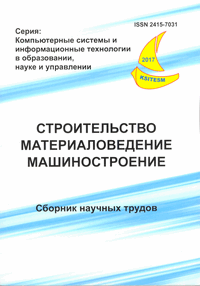Investigation of reflective capacity of materials with express method for development of effective thermal protective coatings
Keywords:
intensity of thermal radiation, non-destructive testing, measurement of reflectivity, infrared LED, polarization abilityAbstract
Purpose. Selection and enhancement of the measurement capability of domestic instruments used for express methods for estimating the reflectivity of surfaces of heat-shielding means taking into account the variable angle of incidence of radiation, the state of the surface and its polarization ability. Method. Express method of non-destructive testing and assessment of the reflectivity of the surfaces of heat-shielding means taking into account the variable angle of incidence of radiation, the state of the surface and its polarization ability. Results. The shortcomings of the existing express method for estimating the reflectivity of materials with allowance for polarization are revealed and its improvement is improved by improving the measurement capability of the IR emitter and developing an apparatus that allows to evaluate the reflectivity of thermal protection means taking into account the varying angle of incidence of radiation. A special technique has also been developed for selecting the optimal matching of protective equipment against excessive heat radiation, depending on the purpose of thermal protection. By selecting the components of the composite composition, the spectrum of the radiator is completely overlapped, several components of the composite composition can be used for this. The ranges of spectral reflection of components of heat-shielding materials for protection against low and high-temperature sources are determined. Scientific novelty. Improvement of instruments for measuring the radiant component of the heat flux, which made it possible to estimate the intensity of radiation at workplaces not only from direct sources, but also from transformed, secondary sources. Practical meaningfulness. The proposed instrumentation allows measurements of the heat flux intensity from 10 W / m2 and up to 20,000 W / m2 with a spectral capability of measuring from 0.76 μm to 10 μm, resolution of 5 W / m2 with a measurement error of not more than 5%.References
Ametistov E.V. Osnovy teorii teploobmena [Fundamentals of the theory of heat transfer]. Moscow: MEI, 2011, 242 р.
Вelikov A.S., Ragimov S.Yu., Shalomov V.A. and Chaplyigin A.S. Kontrol vyisokotemperaturnogo izlucheniya na rabochih mestah [Control of high-temperature radiation jobs]. Stroitelstvo, materialovedeniye, mashinostroeniye [Construction, materials science, mechanical engineering]. PDABA–Dnipropetrovsk, 2015, no. 80, pp. 49 - 54 (in Russian).
Belikov A.S., Strezhekurov E.E., Shalomov V.A., Ragimov S.Yu. and Kordunov S.P. Resheniye zadach po zaschite rabotnikov spetspodrazdeleniy v usloviyakh ekstremalnykh situatsiy po teplovomu vozdeystviyu [Decision on the protection of
workers' special forces tasks in extreme situations on the thermal effects] Stroitelstvo, materialovedeniye, mashinostroeniye [Construction, materials science, mechanical engineering]. PDABA–Dnipropetrovsk, 2015, no. 82, pp. 25 - 31 (in Russian).
Zigel R. and Khauehll Dzh. Teploobmen izlucheniyem [Radiation heat transfer]. Moscow: Mir, 2005, 934 р. (in Russian).
Belikov A.S., Safonov V.V., Nazha P.N., Chalyy V. G., Shlykov N.Yu., Shalomov V.A. and Ragimov S.Yu. Okhrana truda v stroitelstve [A labour protection is in building]. Kyiv: Osnova, 2014. 592 р. (in Russian).
Belikov A.S., Ragimov S.Yu. Kaplenko G.G. and Kravchuk A.M. Issledovaniye termodinamicheskoy napriazhennosti na rabochikh mestakh s vysokim teplovydeleniyem [Study of thermodynamic tension in workplaces with high heat release]. Kommunal'noe khozyaystvo gorodov: sb. nauchn. tr. [Municipal economy of cities] Kharkоv, 2011, vol. 99, pp. 3-8. (in Russian).
Belikov A.S., Ragimov S.Yu., and Kaplenko G.G. Osnovnyye trebovaniya, prediavliaemyye k sredstvam zaschity ot infrakrasnogo izlucheniya na rabochikh mestakh [The basic requirements for the means of protection from infrared radiation in the workplace]. Bezpeka zhyttiediialnosti liudyny yak umova staloho rozvytku suchasnoho suspilstva: Materialy Tretoi Mizhnarodnoi naukovo-praktychnoi konferentsii. [Safety of human life as a condition for the sustainable development of modern society: Materials of the Third International Scientific and Practical Conference]. Kharkiv, 2010, vol. 91, pp. 262-267. (in Russian).
Strezhekurov E.E. Osobennosti issledovaniya termoradiatsionnoy napriazhennosti v goriachikh tsekhakh promyshlennosti [Features of the study of thermoradiation tension in hot shops of industry]. Sistemnye tekhnologii [System technologies]. 2009, no. 4, pр. 15-18. (in Russian).
Downloads
Published
Issue
Section
License
Редакція Видання категорично засуджує прояви плагіату в статтях та вживає всіх можливих заходів для його недопущення. Плагіат розглядається як форма порушення авторських прав і наукової етики.
При виявлені у статті більш ніж 25% запозиченого тексту без відповідних посилань та використання лапок, стаття кваліфікується як така, що містить плагіат. У цьому випадку стаття більше не розглядається редакцією, а автор отримує перше попередження.
Автори, в статтях яких повторно виявлено плагіат, не зможуть публікуватися в усіх журналах Видавництва ДВНЗ «Придніпровська державна академія будівництва та архітектури».
Автори, які публікуються у цьому журналі, погоджуються з наступними умовами:
- Автори залишають за собою право на авторство своєї роботи та передають журналу право першої публікації цієї роботи на умовах ліцензії Creative Commons Attribution License, котра дозволяє іншим особам вільно розповсюджувати опубліковану роботу з обов'язковим посиланням на авторів оригінальної роботи та першу публікацію роботи у цьому журналі.
- Автори мають право укладати самостійні додаткові угоди щодо неексклюзивного розповсюдження роботи у тому вигляді, в якому вона була опублікована цим журналом (наприклад, розміщувати роботу в електронному сховищі установи або публікувати у складі монографії), за умови збереження посилання на першу публікацію роботи у цьому журналі.
- Політика журналу дозволяє і заохочує розміщення авторами в мережі Інтернет (наприклад, у сховищах установ або на особистих веб-сайтах) рукопису роботи, як до подання цього рукопису до редакції, так і під час його редакційного опрацювання, оскільки це сприяє виникненню продуктивної наукової дискусії та позитивно позначається на оперативності та динаміці цитування опублікованої роботи (див. The Effect of Open Access).

